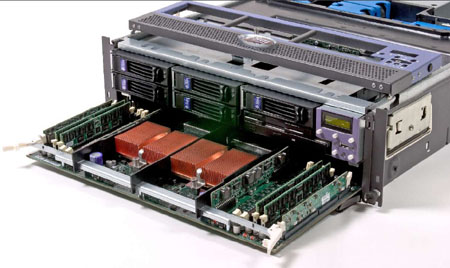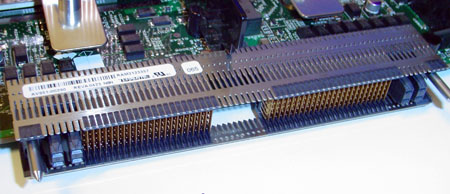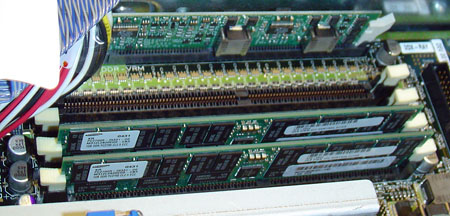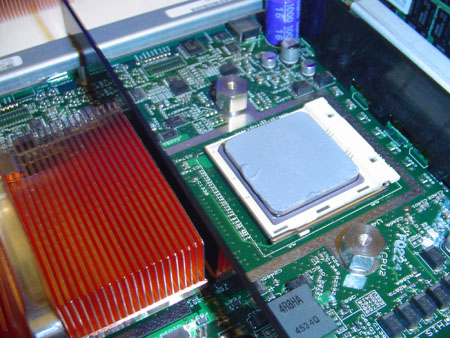Sun Fire V40z: Four Opterons in a 3U
by Kristopher Kubicki on February 22, 2005 12:05 AM EST- Posted in
- Systems
Detailing the Chipsets
The soul of the V40z runs on four Opteron 850 (2.4GHz, 1MB L2, 130nm) processors. The daughterboard obstructs the majority of the airflow to the rear of the system, so plastic rails partition air to each bank of memory and each processor. The cooler air from the hard drive bays is pulled over the daughterboard to cool the rear processors. You'll notice that there is no active cooling on this portion of the chassis; fans directly opposite the daughterboard (slightly above the mainboard) pull cool air from the outside of the case directly over these heat sinks.The daughterboard connects to the mainboard via a proprietary Sun interface, but with the rails and guides holding the daughterboard, we had no problems determining if we had a clean connection between boards.
As with any Opteron system, each processor has a dedicated bank of memory; in our case, two Samsung 1GB PC2700 modules per processor. The older 130nm "CG" stepping on Opteron 8xx only allows for PC2700 memory in Sun's V40z, but the newer "E4" stepping now supports PC3200 as well. We will get more into Sun's 90nm "E4" stepping solution in just a bit. Each processor bank can utilize 8GB of memory (four DIMMs) in 64-bit operation, giving the V40z a total capacity of 32GB.
Behind the bank of DDR DIMMs in the image above, we can also see the 12V individual voltage regulator module (VRM). With larger processor configurations, regulating clean power to each processor becomes essential, and thus, each processor has a dedicated VRM. Below, you can see one of the Opteron 850s is exposed from under the copper heat sink on the daughterboard.














38 Comments
View All Comments
tironside - Thursday, February 24, 2005 - link
I agree with dwnwrd. the lom part of it is not great for remote console etc. the lom that the hp stuff has is pretty slick, with a java / web interface. The other main problem I have with this is it offers only raid 1 unless you buy a rather expensive add on card to do raid 5, kind of a teaser to put 6 drive bays and only let you do raid 1... It's a good start, but sun needs to make some changes before it can go mission critical. (raid and lom enhancements imho) while I like cli stuff, trying to get junior people to do complicated cli stuff is dangerous...dwnwrd - Thursday, February 24, 2005 - link
I have some V20s and a V40. The service processor is pretty great except if you try to direct the Linux serial console to it then connect to the "serial over LAN" you'll get a flood of "serial8250: too much work for irq4" and a sleepy system.http://supportforum.sun.com/hardware/index.php?t=m...
Pontius - Thursday, February 24, 2005 - link
I am curious what they are using when they benchmark the linux kernel compile times. They use the time command which spits out three times - real, user & sys. Are they using the sum of all these? If not, something is wrong. Because I did the same test, on the same 2.6.4 kernel using -j2 on a dual 2.8GHz Nocona system and I got a "real" time of 147s. That doesn't seem right because the Opterons are way faster at compilation. On the other hand, if I take the sum of the 3 times, I get 420s. Any thoughts?jlee123 - Wednesday, February 23, 2005 - link
RedHat 9, are you joking!!?? This has got to be a mistake, I can't understand how Sun could be shipping a 64-bit server with a 32-bit OS that's reached End Of Life. It's the equivalent of buying a workstation with Windows ME on it. Also, there was never a official port of RH9 to x86-64, the first x86-64 RedHat was RHEL3, the Fedora team later released FC1 x86-64. If Sun doesn't wish to pay licensing, they'd be better off shipping with FC2, FC3 or CentOS, a free rebuild of RHEL. This hardware isn't even going to begin to be utilized till it's running something more modern like RHEL4 x86-64.JustAnAverageGuy - Wednesday, February 23, 2005 - link
I could think of one use for these. :)http://forums.anandtech.com/categories.aspx?catid=...
lauwersw - Wednesday, February 23, 2005 - link
Standard rule for parallel make is to use 2xnumber of processors available. This gives most optimal results to hide disk latencies and seems to be correct in most cases I've seen.phaxmohdem - Wednesday, February 23, 2005 - link
Call me what you will, but I would like to see some quad/dual Xeon scores to compare to as well (along with price tages for comparison :) )And yes, If I were a rich man who knew what to do with that much computing power, I would have a dozen of these babies in my basement! Who needs women anymore once you have 48 Opteron x50 or x52 cpus humming at your disposal. And drool core? Ahhhhhhhhhhh.
JustAnAverageGuy - Tuesday, February 22, 2005 - link
That thing is a BEAST.I have no idea what I'd do with a computer like that.
MrEMan - Tuesday, February 22, 2005 - link
Kristopher,Thanks for the clarification about the reduced media tag.
E
KristopherKubicki - Tuesday, February 22, 2005 - link
RyanVM: The system used 850s.Kristopher